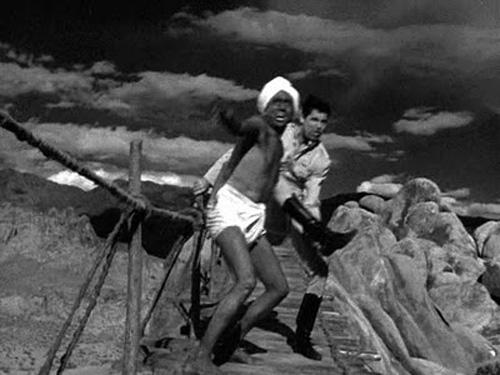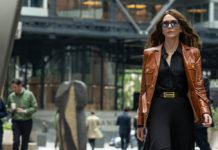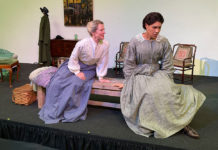Are you old enough to remember “the thrilling days of
yesteryear” when Silver (with the mask-wearing Clayton Moore on his
back) galloped across your TV screen to the driving music of the
William Tell Overture in “The Lone Ranger”? Or perhaps you recall
the scene in “Ironman” where Tony Stark (Robert Downey Jr.)
displays the awesome power of his weaponry with a massive explosion
at the base of a snow-capped mountain range? Or the landscape where
giant worms devour an entire truck in “Tremors?” Or the rickety
rope bridge strung across a vast gorge in “Gunga Din”? If so, then
you are already familiar with the picturesque rock-strewn country
of the Eastern Sierra called Alabama Hills, which served as the
location for over 400 movies.
Confusingly named after a Civil War battleship, the Alabama
Hills are situated smack dab in the middle of California Highway
395, just west of the small town of Lone Pine. The best
introduction to the cinematic history of this oddly familiar
collection of weirdly eroded rocks is Beverly and Jim Rogers’ Lone
Pine Museum of Film History.
Expecting a dusty, cob-webbed, back yard sort of place, I was
pleasantly surprised to discover a modern and immaculate film
museum complete with a large screening room, several historic movie
cars, and an extensive collection of priceless movie memorabilia
showcased in thematically arranged rooms.
As you enter the lobby, you can’t help but notice the stretched
1975 Cadillac Eldorado convertible festooned with chromed pistols
and rifles, silver dollars and the massively long horns from some
gigantic bovine owned by the costume designer Nudie, Hollywood’s
original “king of bling.” Overwhelmed by all the glitter and glam,
I stopped at the front desk to ask about the best way to view the
collection. The helpful Tammy Emley guided me into the museum’s
Wild West Theater for a private screening of a well-made, 15-minute
documentary of the Hollywood stars and the movies they filmed
nearby. Starting off with clips from the historic silent film “The
Round Up,” featuring Fatty Arbuckle, and continuing with
black-and-white classics like “Gunga Din,” and “Brigham Young,” the
documentary continues with clips from the hundreds of films made by
Republic and other Hollywood studios. Most of these so-called
“B-movies” were shot in a few short weeks and several featured
popular singing cowboys like Roy Rogers and Gene Autry, but other
genres like Tarzan movies and gangster films are shown as well.
Then, after glimpses at several recent big-budget films “Star Trek
V and VII,” and “Gladiator,” and some classic TV shows like “The
Lone Ranger,” and “Annie Oakley,” the documentary ends with the
Statler Brothers singing their musical tribute “Whatever Happened
to Randolph Scott?” As I heard the words “Whatever happened to Gene
and Tex and Roy and Rex…Lash LaRue… and Smiley Burnette, Tim Holt
and Gene Autry? Whatever happened to all of them has happened to
the best of me,” I watched brief scenes featuring all these stars
filmed against the backdrop of the iconic Alabama Hills.
Tammy then directed us to the first of several rooms of movie
memorabilia. Featuring photos, costumes, props, scripts and other
ephemera, each of the areas covers a different concept. The
motorized rubber head of the worm from “Tremors” is close to the
entrance of the secret cave where Tony Stark was held captive in
“Ironman,” while cowboy hats from almost a hundred movie stars
cover the wall in another room. Duplicates to the Gene Autry cowboy
boots, Hopalong Cassidy lunchbox, and Roy Rogers guitar I played
with as a kid are on display along with a plethora of games,
glasses, cap guns and dishware emblazoned with familiar names or
faces and a full size stagecoach and historic movie cars delineate
other sections of this extensive collection.
After the museum, I took the self-guided auto tour through the
Alabama Hills to see some of the iconic locations in person. Great
fun! (The BLM tour guide is downloadable at the museum’s website:
www.lonepinefilmhistorymuseum.org.
Comments? E-mail gi*********@co*****.net.
49.7
F
Healdsburg
April 20, 2025








